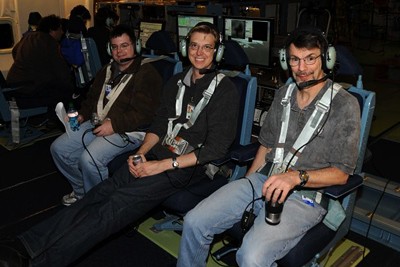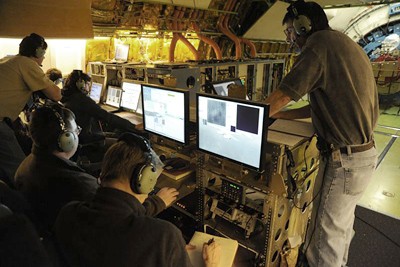On new NASA observatory, Cornell-built infrared camera plays starring role
By Lauren Gold
For Cornell astronomer Terry Herter and the team behind FORCAST, the Faint Object infraRed Camera for the SOFIA Telescope, tonight's (May 25) flight will be the culmination of 13 years of planning and design – and the beginning of the camera's career as a key instrument on NASA's new airborne observatory.
FORCAST is projected to play a central role over SOFIA's 20-year lifetime – and to help answer longstanding questions about star formation, galactic nuclei, properties of the interstellar medium and more.
The camera operates at wavelengths of 5 to 40 microns, a part of the spectrum known as the mid-infrared. Unlike cameras that image in optical wavelengths, it can see through dust in space and provide a multicolor view of places that are otherwise obscured – including the center of our galaxy, nearby galaxies and areas around newly forming stars and young star clusters.
It will also be used to investigate the dust around nearby stars, which could answer questions about our solar system. "That dust has to be replenished, because it turns out it migrates out of the system – it's either blown out or it spirals into the stars," said Herter, the principal investigator for the instrument. "We're hoping to find evidence of what's going on there."
FORCAST will also be used to characterize the composition, distribution and temperature of dust clouds and to investigate their source. And it can look closer to the sun than a space-based telescope, so researchers will be able to use it to investigate the inner part of our solar system.
Cooled with liquid helium to 4.2 degrees Kelvin, FORCAST can collect up to 500 images per second and provide the highest spatial resolutions possible with SOFIA, resolving fine details better than its predecessor, the Kuiper Airborne Observatory, by a factor of three.
The instrument has evolved since its inception in 1997, but it has remained a distinctly Cornell project throughout, Herter said. "This was really truly built at Cornell, unlike when you do a space mission and you're just a PI, and it's built off campus."
Along with Herter, the core FORCAST team includes five other Cornell researchers, and a sixth who was the project scientist at Cornell from 1999 to 2003 and now is an astronomy professor at Ithaca College.
This week's flight will be FORCAST's first on SOFIA, but the instrument is already well traveled. Parts have been shipped back and forth between Cornell and SOFIA's home base, the NASA Dryden Aircraft Operating Facility at Palmdale Airport, Calif., during development; and it got a first look into the sky from the Palomar Observatory at Mount Palomar, Calif. It was delivered to Palmdale Feb. 8 and installed on SOFIA by lead engineer and Cornell research support specialist George Gull and colleagues May 7.
Along with investigating some of the mysteries of the universe, Herter said, education and public engagement are key pieces of the FORCAST mission. As part of that goal, data from the instrument will be available online; and educators will be invited to join scientists on flights once operations are up and running.
After an initial period in which Herter's team has priority in using FORCAST, the camera will be turned over to the observatory and open to users from around the world.
Get Cornell news delivered right to your inbox.
Subscribe
